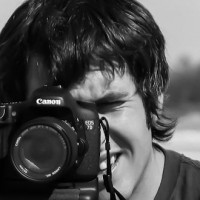Summer is coming, so are the most lovely creatures in the world of insects: ladybirds. Ellen van Deelen's passion for photography often leads her to shoot this little wonders of nature. She explains here how she succeed to capture them in this exquisite image.
To make sure I have the flowers that I want to use in my backgrounds, I plant them in a park in my village. Growing your own set takes time, but it gives you great control of your work.
I love to take macro photos, and especially ladybirds on flowers. When I first started to take these photos, I photographed the ladybirds in their natural surroundings. But soon I realized that I really didn't like most of the backgrounds. So I started buying flowers that I liked, and then I planted them so I could use them later in my backgrounds. I do not have a garden at home, so I planted the flowers in a nearby park. It’s a safe and quiet place, and there are lots of plants and insects there.
"So I sat with my back to the sun to project my shadow over my small subjects and set. Instant and convenient diffusion!"
For this shot, I put my tripod at its lowest setting, and as I positioned myself behind the camera I noticed that the afternoon sun was too strong. So I sat with my back to the sun to project my shadow over my small subjects and set. Instant and convenient diffusion! I put my camera bag on the ground and then propped up a white piece of paper against the bag. In front of the paper I arranged some forget-me-nots — the blurry, out-of-focus blue flowers in the background. I pointed the camera a bit downward so that both the light and the background worked well for this composition. In my left hand I held the flower on which the ladybirds sat. This way, I could move the flower around until it was in a good position in the photograph.
"One more thing: I almost forgot to mention how I found the ladybirds!"
I was happy with the result. It was most important to me that the ladybirds appeared sharp and that the composition was strong and effective. Just as important is a colorful and complementary background, and I was happy with the way this one turned out. The ladybirds moved all the time, so I had to be quick to capture them at just the right moment. I have learned to take photos very fast. If you wait too long, you’ll probably be too late. One more thing: I almost forgot to mention how I found the ladybirds! There are some boxwoods (buxus) in a graveyard near the park. Last time it took me half an hour to find a few of my models! After the shoot, I put them back where I found them, but of course, sometimes they just fly away.
This image did not need much editing. When I process my photos, I use Adobe Photoshop CS6, and I often use Nik Color Efex Pro plugin to enhance the colors.
I always make sure the Levels are good.
I reduce Noise and I Sharpen my photos a bit.
In this photo there was some sand on the ladybirds and flowers. I removed it by using the Clone Stamp tool.
I used Nik Color Efex Pro plugin to adjust the colors to the beautiful color scheme that you see in the final image.
I usually take about 400 photos in one afternoon. The number of photos I take depends on the light, the ISO and the aperture — I like to make sure all bases are covered. I frequently need one more stop so I don't underexpose my photo. I under- and overexpose a lot, especially with macro photography.
I always check the histogram on the camera's LCD while I'm shooting to make sure my exposures are correct. It's a great tool and I watch it closely to ensure that there are no spikes in the shadows or highlights.
The light is very important. I try to never take close-ups in full sunlight. Also, I prefer to shoot when it isn't too windy or dark and dreary outside — a bit of sun and a bit of clouds is ideal.
I use autofocus because the insects move most of the time. I like a blurry background, so I always choose a wide aperture which produces a shallow depth of field. In addition to ladybirds, I like to photograph bees and many other insects.
I am from the Netherlands. My favorite hobbies are painting, drawing, photography and music.










